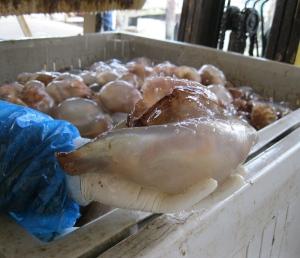
Stomolophus meleagris, source: uk.wikipedia, permission by user: Shao
Such is the case with cannonball jellyfish, an edible jellyfish species popular in China and other parts of Asia for its firm, crunchy texture.
Over the last 20 years, interest in cannonball jellyfish in the Gulf of California, Mexico exploded when Chinese investors saw that the area was a hot spot for the species.
“The suite of actors who are at play in this jellyfish fishery is extremely complex,” said Lucas Brotz, an honorary research associate at the Institute for the Oceans and Fisheries (IOF), postdoctoral fellow of the Sea Around Us initiative and lead author of a new paper, which details the history and failed management strategies of the fishery.
“There’s fishers who have permits, fishers who don’t have permits, fishery co-operatives, processing plant owners, the people who work in the processing plants, the brokers from Asia, academics, governmental managers, Indigenous groups that fish in their territorial waters — everyone shouting different information, politely arguing about when to open the fishery and how to manage it. It struck me that these jellyfish are such simple creatures, and it’s actually the humans that are difficult to manage.”

Cannonball Jellyfish (Stomolophus meleagris) by guppiecat, CC BY-NC-ND 2.0
Fishers first cast their scoop nets in the central gulf, pursuing the blue jellyfish. From 2001 to 2015, catches either rose or stayed fairly consistent, with occasional drops, but they plummeted in 2016, possibly due to overexploitation. At its height, in 2011, the fishery caught almost 40,000 tonnes of jellyfish. Catches there have remained low since 2015, another peak year.
History could be repeating itself in the northern fishery, which became Mexico’s jellyfish fishing hub shortly after the decline of the blue jellyfish. This year saw an all-time high: 100,000 tonnes of jellyfish catch.
Both fisheries have been managed loosely, with little to no enforcement of rules limiting catch, the number of permits given to fishers, or size limits on smaller jellyfish. This has resulted in a “race to fish,” which encourages fishers to catch as many of the valuable jellyfish as possible without concern for the sustainability of a fishery that benefits the local economy.
The fact that the jellyfish are highly visible, move slowly and appear seasonally, means that they look like “money floating in the water,” according to the study, published in Marine Policy.
“It’s disheartening to see this all-too-familiar trajectory of ‘boom and bust,’ at least for the species in the central gulf,” Brotz said. “There were a number of good recommendations for how to manage this fishery—the first one being to take a precautionary approach and not catch too many before we know what the implications are. That was basically ignored.”
Further complicating matters, cannonball jellyfish populations vary dramatically.

By VOA – P. Graitcer – VOA, Public Domain
In order to keep these fisheries sustainable, Mexico needs more control over the price of jellyfish, as it is primarily in the hands of Chinese brokers, Cisneros said.
In addition, compliance to fishing rules must improve, fishers must cooperate with one another, and they must catch jellyfish only after they have spawned, which is when they enter the end of their life cycle.
“I have hope because there are negotiations happening between Mexico and China,” Cisneros said. “I think the main problem right now is the race for the jellyfish due to the strong incentive from the money coming from Asia. Otherwise, I think fishers would do the right things, even without officers enforcing the rules and regulation. They know it’s good for them to have a sustainable fishery.”
Tags: fisheries management, jellyfish, Lucas Brotz, Mexico, Research, Sea Around Us